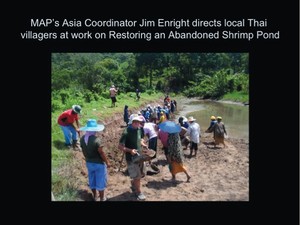Electric Cars, Windmills…..and Mangroves
Dear MAP News Reader
Each morning you shower, dress, have your coffee and breakfast, then drive to work, where you use computers or some other kind of electrically-powered machine, then drive home and enjoy your dinner in a well-heated or air-conditioned home abundantly lit in the evening darkness. You do this day in and day out, and at the end of a year, you have disgorged into the atmosphere 9 tons of carbon.
Yes, the average US citizen emits nine tons per year of the most dangerous pollutant on Earth – the carbon contained in greenhouse gases, primarily CO2. Hurricane Katrina and last summer’s crop-killing record-setting heat wave are harbingers of worse climactic disasters to come. The clock is ticking. We must change the way we live and move towards a world of electric cars and buses powered by windmills and other sustainable energy sources. But the number one cause of greenhouse gas accumulation is not our cars or power plants. It is deforestation – the loss of our forests, which have the magical power to sequester carbon, to take it out of the atmosphere and put it safely into plant biomass and the soil.
And that’s where mangroves fit into the picture as surely as do electric cars and windmills, because mangrove forests can sequester three to five times more carbon per hectare than tropical rainforests, as much as 15 tons per hectare every year.

But the world has already lost half its mangroves, and more are lost each year to shrimp farming and developers’ bulldozers. This destruction must stop, the surviving mangroves must be preserved, and where they have been destroyed they must be restored.
The Mangrove Action Project (MAP) is at the forefront of this work so vital to our planet’s survival. Our projects conserve and restore mangroves, and educate and empower coastal peoples to steward and draw sustainable livelihoods from their mangrove forests. Today, MAP is undertaking an increasing program load involving mangrove restoration in Asia, Latin America and soon Africa as well. However, at a time when our work is so desperately needed, we find ourselves needing funds to expand our work to a new higher level. We need your help.
So we are calling on our members and friends to donate to MAP today. Because one thousand dollars – $1,000 –restores a hectare of mangroves, a contribution of $600 can offset your yearly 9 ton contribution to global disaster. Even a modest $50 can offset your carbon emissions for a month. With this money MAP can expand its work into new countries and preserve and restore hundreds and eventually thousands of hectares of the unsung heroes of the battle against climate change- the marvelous mangroves.
—————————————————————–
Yes, I want to help Mangrove Action Project combat climate change with my gift of
___$25 ___ $50 ___ $100 ___ $250 ___ $600 ___ $1000 ___ Other $___
You can send a check or money order to MAP at
PO Box 1854, Port Angeles, WA 98362-0279
You can also securely donate with a cheque drawn on a US or Canadian bank, or International Money Order, or make a payment by Credit Card via PayPal or Network for Good via MAP’s website at: www.mangroveactionproject.org
Our Gift To You For Your Pledge of $25 or More
Receive the newest Mangrove Children’s Art Calendar when you donate $25 or more. Or print out the attached form and mail your order for additional quantities at just $12 (plus postage) each See details below.

